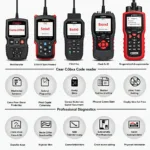The OBD2 code P0030, indicating a problem with the heated oxygen sensor (HO2S) control circuit, can be a frustrating issue for car owners. This comprehensive guide dives deep into the P0030 code, exploring its causes, symptoms, diagnostic procedures, and potential solutions, empowering you to address this issue effectively.
What is OBD2 Code P0030?
The P0030 code specifically refers to a malfunction in the heater control circuit of the bank 1 sensor 1 oxygen sensor. “Bank 1” refers to the side of the engine containing cylinder 1, and “sensor 1” designates the upstream oxygen sensor, located before the catalytic converter. This sensor plays a crucial role in monitoring the exhaust gas oxygen content, which the engine control module (ECM) uses to adjust the air-fuel ratio for optimal performance and emissions control. The heater element within the oxygen sensor ensures it reaches operating temperature quickly, allowing for accurate readings shortly after starting the engine. A fault in this heater circuit triggers the P0030 code.
Symptoms of a P0030 Code
Recognizing the symptoms associated with the P0030 code can help you identify the problem early on. Common symptoms include:
- Check Engine Light: The most obvious sign is the illumination of the check engine light on your dashboard.
- Reduced Fuel Economy: A malfunctioning oxygen sensor can lead to a richer air-fuel mixture, consuming more fuel.
- Rough Idle or Misfires: Incorrect air-fuel ratios can cause the engine to idle roughly or misfire.
- Failed Emissions Test: A faulty oxygen sensor can prevent your vehicle from passing emissions tests.
- Performance Issues: You might notice a decrease in engine performance, such as sluggish acceleration.
Causes of OBD2 Code P0030
Several factors can contribute to the P0030 code. Understanding these causes can guide your diagnostic process:
- Faulty Oxygen Sensor: The most common culprit is a damaged or worn-out oxygen sensor.
- Damaged Wiring or Connector: Wiring issues, such as breaks, corrosion, or loose connections, can disrupt the heater circuit.
- Blown Fuse: A blown fuse in the HO2S heater circuit can cut off power to the heater element.
- Faulty ECM: In rare cases, a malfunctioning ECM can cause the P0030 code, though this is less likely.
“A thorough diagnostic process is crucial before replacing any parts,” advises John Smith, ASE Certified Master Technician. “Checking the wiring and fuses first can save you time and money.”
How to Diagnose and Fix OBD2 Code P0030
Diagnosing the P0030 code involves a systematic approach. Follow these steps:
- Retrieve the Code: Use an OBD2 scanner to confirm the P0030 code and check for any other related codes.
- Inspect the Wiring: Visually inspect the wiring harness and connector for damage, corrosion, or loose connections.
- Check the Fuse: Locate and check the fuse related to the HO2S heater circuit. Replace if blown.
- Test the Oxygen Sensor: Use a multimeter to test the oxygen sensor’s heater circuit resistance and voltage.
- Replace the Oxygen Sensor: If the tests indicate a faulty sensor, replace it with a new one.
- Clear the Code: After repairs, clear the code using the OBD2 scanner and verify the issue is resolved.
What if the Code Returns After Replacing the Oxygen Sensor?
If the P0030 code returns after replacing the oxygen sensor, it indicates a more complex issue. Consult a qualified mechanic to diagnose and address potential problems with the ECM or other related components.
“Don’t ignore persistent codes,” warns Maria Garcia, Automotive Engineer. “Recurring issues could point to underlying problems that require professional attention.”
Conclusion
The OBD2 code P0030 signals a problem with the heater control circuit of your oxygen sensor. By understanding the causes, symptoms, and diagnostic procedures, you can effectively address this issue and ensure your vehicle runs smoothly and efficiently. Don’t hesitate to consult a professional if the problem persists after initial troubleshooting. Addressing the P0030 code promptly can prevent further damage and maintain optimal vehicle performance.
FAQ
- Can I drive with a P0030 code? While you can drive for a short period, it’s best to address the issue promptly to avoid potential damage and reduced fuel economy.
- How much does it cost to fix a P0030 code? The cost can vary depending on the cause and whether you perform the repair yourself or hire a mechanic.
- How often should I replace my oxygen sensors? Oxygen sensors typically last between 60,000 and 90,000 miles.
- Can a bad catalytic converter cause a P0030 code? While less common, a failing catalytic converter can sometimes contribute to oxygen sensor issues.
- Will a P0030 code affect my car’s performance? Yes, a faulty oxygen sensor can negatively impact fuel economy, engine performance, and emissions.
- What tools do I need to diagnose a P0030 code? An OBD2 scanner and a multimeter are essential tools for diagnosing this code.
- Can I clear the P0030 code myself? Yes, you can clear the code using an OBD2 scanner after addressing the underlying issue.
For further assistance, please contact us via WhatsApp: +1(641)206-8880, Email: [email protected] or visit us at 789 Elm Street, San Francisco, CA 94102, USA. Our customer service team is available 24/7.

